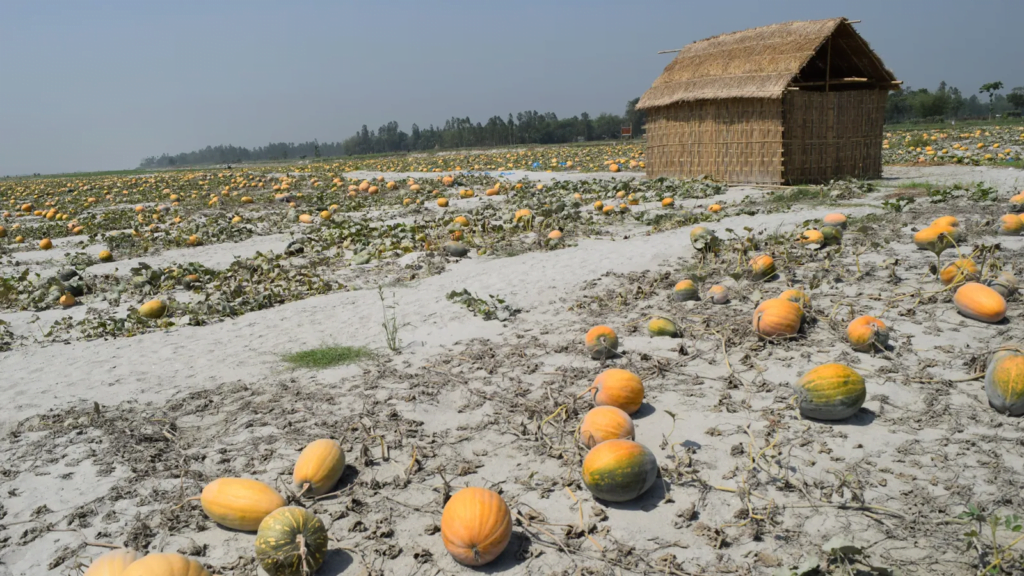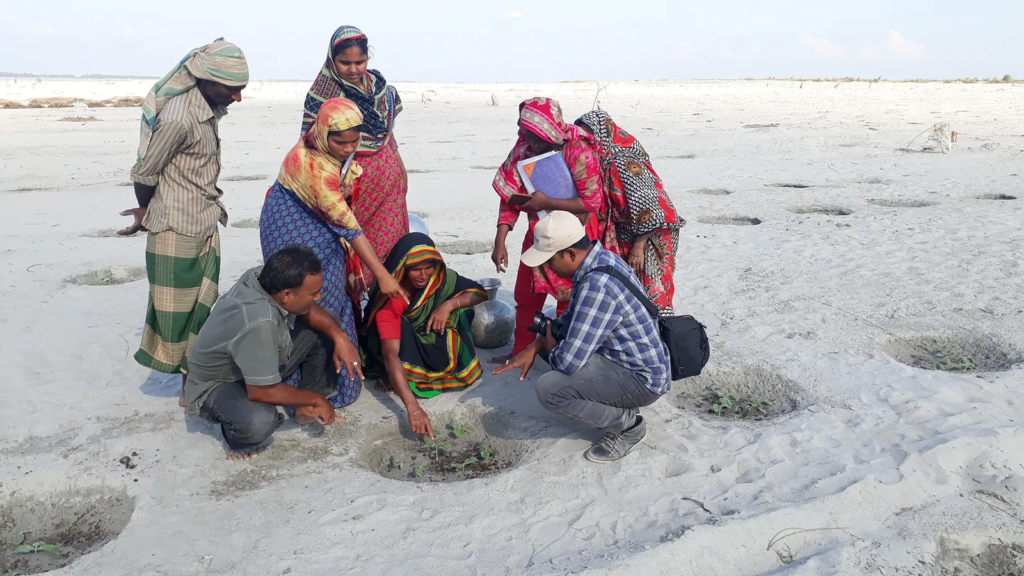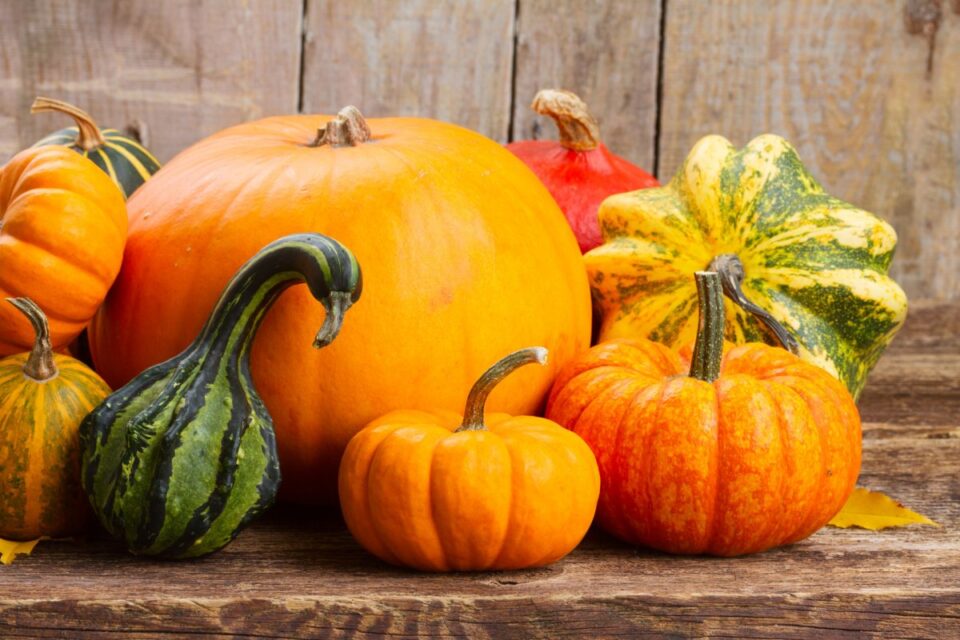In the West, pumpkins may be the main ingredient in a traditional holiday pie, but their true potential lies in their nutritional and medicinal benefits. Rich in various essential nutrients and relatively easy to grow, this hardy, drought-tolerant crop is underrated. Pumpkins offer great promise as farmers battle with water scarcity and increasingly harsh climates, local communities struggle with economic insecurity, and the the world’s population is increasingly undernourished.
In Bangladesh, mini deserts – known as sand bars – are formed due to climate change-caused flooding during the torrential rains of the five month-long monsoon. The sediments deposited contain highly toxic elements due to river pollution, and they render the land infertile. However, these river-eroded, silt-covered lands are now being harnessed to grow pumpkins to help tackle food insecurity, unemployment, and malnourishment.

In Bangladesh, pumpkins are being grown in mini deserts to help tackle food insecurity, unemployment and malnourishment (Credit: Nazmul Chowdhury)
What started in 2005 a project called “Pumpkins against Poverty”, formed by the non-profit Practical Action, has now turned into a profitable enterprise called Pumpkin Plus. “We are working with over 1,000 agri-entrepreneurs, exporting pumpkins to Qatar, Malaysia, Singapore, and other countries, and building the capacity of the local communities to diversify to commercial agriculture,” says Nazmul Islam Chowdhury, chief executive of the company. “On average [these communities] earn around £6,000 ($7,340) in a span of five months.”
Pumpkins are an ideal plant for water insecure regions due to their tolerance of drought. Given their ability to withstand less water and salinity, as well as the fact that Bangladesh farmers can make a good profit compared to other produce, they are the preferred crop to be grown in the sand bars. Researchers from Selcuk University, Turkey, are trying to develop novel varieties of pumpkins based on certain cultivars that will result in a more drought-tolerant crop.
Pumpkin fruits are important sources of essential vitamins, minerals, and fats, especially in developing countries – Sarah Hind
Chowdhury and his team face challenges due to unpredictable flooding in Bangladesh. But plant breeding expert Prince Matova, who works for Zimbabwe-based Mukushi Seeds, hopes that adaptive capacities of the crops can be enhanced through various strategies. “[For example] breeding for early onset or shorter seasons, adopting regenerative farming practices, establishment of supplementary irrigation systems, and increasing the resilience of food security crops to environmental stresses.”
Pumpkins are not only found to be well suited to growing in water stressed regions, but also considered beneficial for the soil they are being grown in. Nassuuna Florence, a policy officer with the Advocacy Coalition for Sustainable Agriculture (ACSA), a network of organisations that work with farmers in Uganda to promote sustainable agriculture, is working on a climate mitigation project through farming of indigenous varieties of pumpkins. The project has chosen pumpkin “based on its ability to reduce erosion, to fix atmospheric nitrogen and reduce nitrogen leaching, and to improve soil health”.
The international science community is certainly showing interest in the crop. In Egypt, amidst the country’s growing water shortage fears, scientists are trying to identify and preserve seeds of heirloom varieties of pumpkins to address food insecurity. In the United Arab Emirates (UAE), a company named Elite Agro, in partnership with the retail chain, Spinneys is growing pumpkins in greenhouses using European innovation and technology with superior temperature-control methods, to cater to the thanksgiving season demand from the UAE’s expat population.

Pumpkins are an ideal plant for water insecure regions due to their tolerance of drought (Credit: Nazmul Chowdhury)
It’s little wonder there’s so much research into pumpkins – they’re also incredibly nutritious. The year-round crop contains antioxidants which help prevent various cancers. Nutrient dense but with a low calorie count, this water-rich fruit is a great source of Vitamin A. The fruit is also rich in beta carotene, vitamin C, vitamin E, iron, and folate all of which strengthen our immune systems. A 2021 study from the University of Putra, Malaysia, called pumpkins a “revolutionary age crop”, adding it is a “balanced food, and more adapted to low soil and atmospheric circumstances than other major crops.”
As they’re so packed with vitamins and nutrients, they’re an ideal crop to grow in regions where nutritional food is hard to come by. “Pumpkin fruits are important sources of essential vitamins, minerals, and fats, especially in developing countries,” says Sarah Hind, an assistant professor in the department of crop sciences at the University of Illinois Urbana-Champaign in the US.
Pumpkin seeds have a high magnesium content, and they also contain tryptophan, an amino acid needed for growth in infants, and maintenance of the body’s muscles and proteins.
One company in Uganda, Byeffe Foods, specialises in making value-added pumpkin products such as flour that is added to soy, millet, and rice flour – and the company grows all of its pumpkins on riverbanks that have been degraded by erosion.
Crops such as pumpkins, and similar highly heat- and drought-tolerant crops, will thrive in a warm and dry environment – Prince Matova
The pumpkin products Byeffe Foods produces are used to feed infants and children as a porridge to support their nutritional needs. In Kenya, vitamin deficiencies amongst children are being addressed through the addition of pumpkin to sorghum flour.
They could be a transformative crop in South Asia and Africa, insists Chowdhury. They’re also ideal for tropical and hot countries, as they have a long shelf life. The vegetables do not rely on a cold chain system of storage and transportation and can stay good for consumption for several months, making them even more suitable for poorer countries where electricity is not always available in rural areas.
“Crops such as pumpkins, and similar highly heat- and drought-tolerant crops, will thrive in a warm and dry environment,” says Matova.
Growing pumpkins does have some challenges. “Pumpkin plants rely on bees to pollinate their flowers, but other insects can be attracted to the flowers and cause damage to the plants,” says Hind. “For example, cucumber beetles feed on the flowers and can transmit bacterial wilt disease, which may devastate entire fields unless controlled through insecticide treatments.”

Pumpkins are a drought-tolerant, nutritional and versatile crop (Credit: Nazmul Chowdhury)
But it appears the advantages outweigh the difficulties. In some areas, such as tropical Goa in India, pumpkin vines seem to grow effortlessly from seeds left in compost bins after the flesh is used to make curries. This crop becomes even more valuable when you consider the fact that little of the plant goes to waste – the fruit, the seeds, the flowers, the leaves and even the stem, albeit only the tender ones, can all be eaten.
Pumpkin leaves are eaten in some parts of the world, for example India and other South East Asian countries, and they also double as feed for livestock and marine life.
A crop that is easy to grow in harsh environments, that is nutritious, one that almost every part can be used in cooking, could be life-changing for communities living food-insecure regions. The four pillars of food security laid down by the UN’s Food and Agricultural Organisation offer a framework to identify promising foods of the future – accessibility, availability, utilisation, and stability – and it seems the humble pumpkin ticks every box.
As we look to feed the planet, embracing the pumpkin as a superfood offers a sustainable path to nourishing a growing global population in a warming world.
The use of the site materials is free if there is a direct and open for search engines hyperlink to a specific publication of the East-Fruit.com website.




